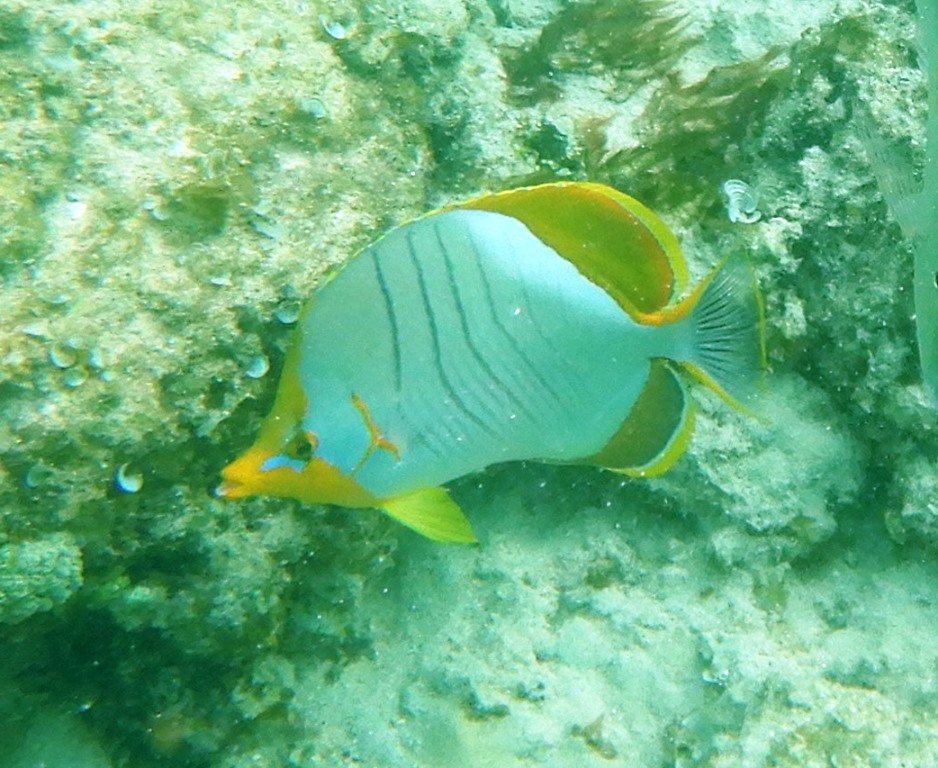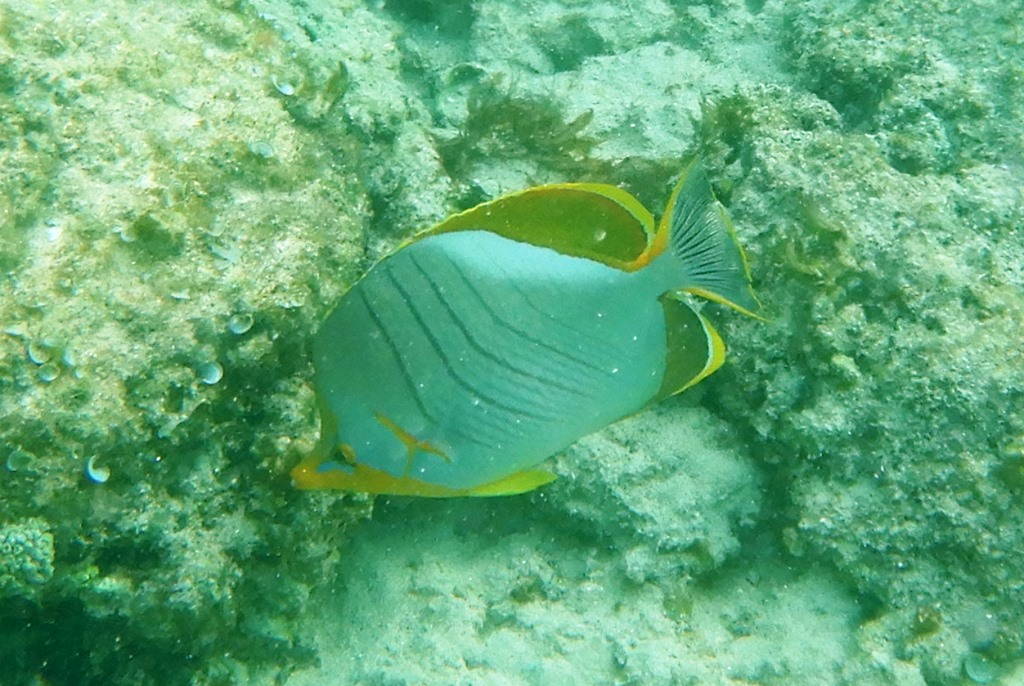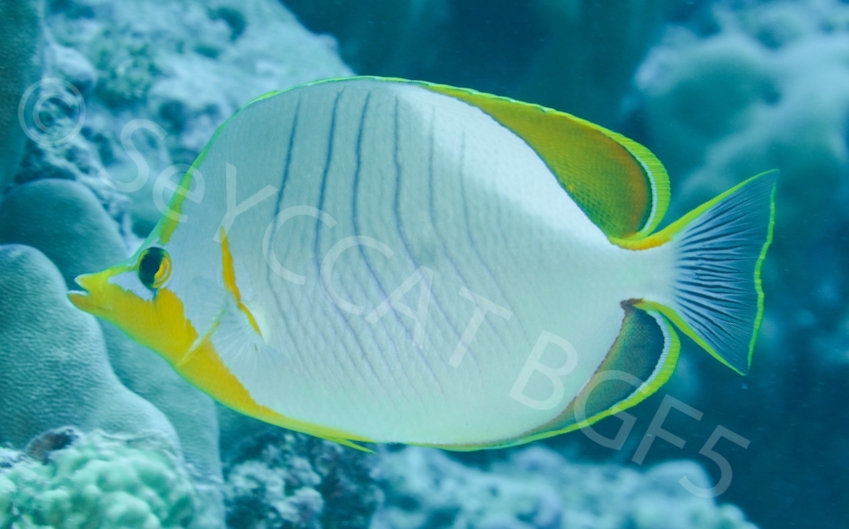Description:
Dorsal spines: 13 - 14; Dorsal rays: 21-26; Anal spines: 3; Anal rays: 21-23.
An uncommon butterflyfish with distinct appearance. Protruded snout with terminal mouth. Dorsal head profile distinctly concave.
Colour. Colour pattern changes considerably with growth. Juveniles are white-bodied with distinctive black eyeband and black spot on peduncle.
Adults are beautifully and subtly coloured. Body is white to pale grey or almost eggshell blue with (5-6) fine grey-blue chevron markings. The forehead, face and breast down
to the pelvic fins is yellow (paler above the eye and richer yellow below) with a small elongate patch of white in front of the eye. The eye is yellow with a dark vertical
bar through the iris. The opercular edge and base of pectoral fin are yellow. The dorsal and anal fins are dusky yellow with peripheral narrow bands of black, white and then
a broad margin of pale yellow. Pelvic fin is yellow. Pectoral fin is hyaline to transparent. The caudal fin has yellow edges but is otherwise hyaline to transparent.
Size:
Maturity: Lm unknown. Range unknown. Max Length: 20cm TL.
Habitat and Ecology:
Associated with rocky reefs rich in algae and coral-rich areas of lagoons (depth 1-30m, usually 2-20m). Usually solitary or in pairs. Roam widely over reefs, feeding on
benthic algae and coral polyps. Oviparous. Form pairs during breeding.
Fishery Status:
This species is not protected or subject to fishery regulations. It may be caught in the trap and net fisheries but would generally be released.
Notes:
1 Photo. courtesy Eleanor Brighton and Chris Mason-Parker (c) 2022 Blue Safari Seychelles/Marine Conservation Society, Seychelles. Photograph taken at Alphonse group 2022.
References:
Froese, R. & D. Pauly. (Eds.) (2020). FishBase. https://www.fishbase.se/summary/Chaetodon-xanthocephalus.html (23/05/20).
Myers, R. & Pratchett, M. (2010). Chaetodon xanthocephalus. The IUCN Red List 2010: https://dx.doi.org/10.2305/IUCN.UK.2010-4.RLTS.T165671A6087151.en. (23/05/20).
Smith, M. & Heemstra, P. (Eds.) (1999). Smiths’ Sea Fishes Edition 6. Springer-Verlag Berlin Heidelberg 10.1007/978-3-642-82858-4
Citation:
Nevill, J.E.G. (2020). Chaetodon xanthocephalus, Yellowhead butterflyfish. Seychelles Seatizens. www.seatizens.sc. https://seatizens.sc/species/chaetodon-xanthocephalus-bennett-1833/ (edited 18/07/22).




very nice put up, i definitely love this website, carry on it
Thank you, I have recently been searching for information about this subject for ages and yours is the best I’ve discovered till now. But, what about the bottom line? Are you sure about the source?
Once I initially commented I clicked the -Notify me when new comments are added- checkbox and now every time a remark is added I get 4 emails with the identical comment. Is there any manner you may take away me from that service? Thanks!
I loved as much as you will receive carried out right here. The sketch is attractive, your authored material stylish. nonetheless, you command get bought an shakiness over that you wish be delivering the following. unwell unquestionably come more formerly again since exactly the same nearly a lot often inside case you shield this increase.
I was curious if you ever thought of changing the page layout of your website? Its very well written; I love what youve got to say. But maybe you could a little more in the way of content so people could connect with it better. Youve got an awful lot of text for only having 1 or 2 pictures. Maybe you could space it out better?
An attention-grabbing discussion is value comment. I feel that you need to write more on this matter, it might not be a taboo topic but usually individuals are not sufficient to talk on such topics. To the next. Cheers
I just could not depart your website prior to suggesting that I actually enjoyed the standard information a person provide for your visitors? Is going to be back often in order to check up on new posts
Does your site have a contact page? I’m having trouble locating it but, I’d like to send you an email. I’ve got some recommendations for your blog you might be interested in hearing. Either way, great website and I look forward to seeing it expand over time.
Thanks a lot for the helpful content. It is also my belief that mesothelioma cancer has an really long latency period of time, which means that the signs of the disease might not emerge right up until 30 to 50 years after the preliminary exposure to mesothelioma. Pleural mesothelioma, that is the most common variety and impacts the area within the lungs, will cause shortness of breath, chest muscles pains, along with a persistent cough, which may bring on coughing up our blood.